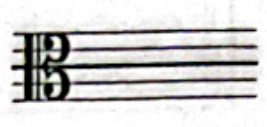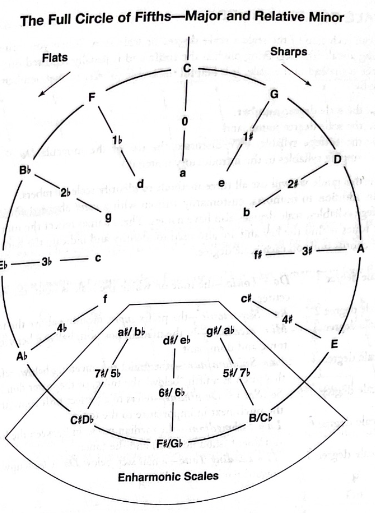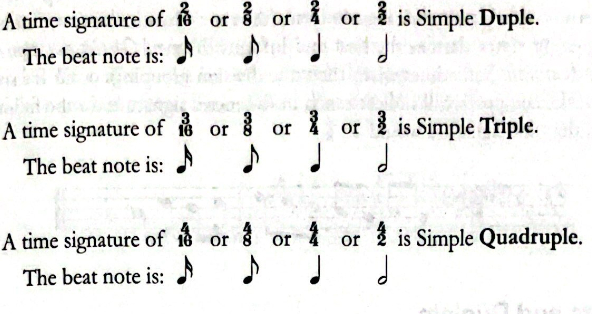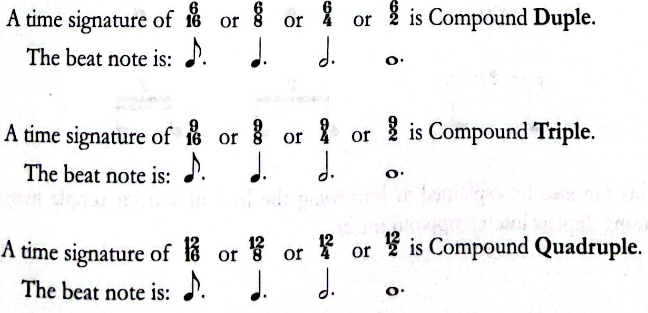Unit 1: Music Fundamentals I: Pitch, Major Scales and Key Signatures, Rhythm, Meter, and Expressive Elements
Pitch and Pitch Notation
Pitch
- Pitch - The highness or lowness of a sound. It is determined by the frequency of the sound wave.
- Measured in hertz (Hz).
The Grand Staff
- Grand staff - A system of two staves - the top staff uses the treble clef and the bottom staff uses the bass clef.
- System - When multiple staves are connected together by bar lines, brackets, or a brace.
- Neutral clef - Used for rhythm only or for pitchless or untuned instruments such as triangle, cymbals, or tambourine.
The Staff and Clefs
Staf (Staves) - Where most music is written. A space of five lines and four spaces.
- Lines and spaces are numbered from bottom to top.
\

\
Clefs - What determines the names of the lines and spaces used.
- Soprano
- Mezzo soprano
- Alto
- Tenor
- Baritone
C clef - Sign used for all of the previously mentioned vocal ranges.
\

\
Movable C clef - The clef that locates middle C and moves around from line to line to designate range.
Alto clef - When the C clef is placed on the third line of the staff.
\

\
Tenor clef - When the C clef is placed on the fourth line of the staff.
\

\
Treble clef - When the G clef is placed on the second line of the staff.
\

\
Bass clef - When the F clef is placed on the fourth line of the staff.
\

Accidentals
- Ledger lines - Small lines that extend the staff while still keeping the five lines and four spaces intact.
- Half step - The smallest space or distance between notes.
- Sharp - Raises the pitch one-half step above its natural pitch.
- Flat - Lowers the pitch one-half step below its natural pitch.
- Natural - The musical symbol that cancels out a flat or a sharp.
- Double sharp - Musical symbol used to raise a pitch by two half steps.
- Double flat - Musical symbol that lowers the pitch by two half steps.
Rhythmic Values
The Dot and the Tie
- Dot and tie - Two symbols that extend the length or duration of a note.
- Dot - Used to extend the value of a single note by one-half of its original value.
- A dotted quarter note divides into three eighth notes.
- Double dot - Lengthens the dotted note value by half the length of the first dot.
- Tie - It combines the durational values of two or more notes of the same pitch using a curved line.
Half Steps and Whole Steps
- Half step - The smallest space or distance between notes.
- Whole step - The distance between two notes that are two semitones or two half steps apart.
Intervals
- Interval - The distance between two pitches.
- They can be melodic or harmonic.
- The exact interval size is described by quantity and quality.
- Quality - Expressed by a number and determined by counting the distance between one letter name and the next letter name.
- All intervals built from the tonic up to notes within a major scale are either major or perfect.
- Perfect intervals
- Unison
- Perfect fourth
- Perfect fifth
- Perfect eighth
- Major intervals
- Major second
- Major third
- Major sixth
- Major seventh
- A minor interval is one-half step smaller than major.
- Diminished interval - An interval that is one-half step smaller than perfect or minor.
- Augmented interval - An interval that is one-half step larger than major or perfect.
- Enharmonic intervals - They sound the same but are spelled differently and function differently.
- Doubly augmented interval - When a major or perfect interval is made one whole step larger without changing the letter names of the pitches.
- Doubly diminished interval - When a minor or perfect interval is made one whole step smaller without changing the letter names of the pitches.
- Consonant intervals - Stable
- Dissonant intervals - Unstable, the impression of activity or tension.
Major Scales and Scale Degrees
Major Scales
Major scale - Created using a pattern for whole and half steps. It’s asymmetrical.

The Circle of Fifths
The circle of fifths - Demonstrates the relationship of the tonal centers to each other.

Key Signature
Key signature - A form of shorthand that dispenses with the writing of accidentals (sharps and flats) for the notes affected by the pattern.
The key signature is always written on the staff between the clef and the meter signature. The placement of sharps alternates in a down-up pattern.
\

The placement of flats on the staff alternates direction in an up-down pattern in both treble and bass clefs.
\

Identifying the Key from the Key Signature
- For sharps - The last sharp in the key signature is scale degree 7, so the name of the key is up one-half step.
- For flats - The last flat in the key signature is scale degree 4, so the name of the key is the next to the last flat in the key signature.
Simple and Compound Meters
Simple Meter
The top number represents the number of beats per measure and the bottom number represents the fractional equivalent of the note that is the beat.
\

Common time - Represented by a lowercase c, it is used to represent 4/4.
Alla breve (Cut time) - Designated by a c with a line going through, is a substitute of 2/2.
Compound Meter
- In compound meter, the time signature represents the subdivision, not the beat.
 Asymmetrical Meters
Asymmetrical Meters
- Asymmetrical meters - Meters that have beat units of unequal length.
- The most common ones have 5 or 7 as the top number.
Meter and Time Signatures
- Meter - The organization of musical time into recurring patterns of strong and weak beats.
- Duple (Strong weak) - Two beats per measure
- Triple (Strong weak weak) - Three beats per measure
- Quadruple (Strong weak less strong weak) - Four beats per measure
Downbeats and Upbeats
- Downbeat - The first beat of the measure.
- Anacrusis - Songs that begin with one or more notes that precede the first full measure.
- Syncopation - The rhythmic displacement of the expected strong beat created by using dots, rests, ties, accent marks, rhythm, and dynamics.
- Hemiola - A special type of syncopation where the bead is temporarily regrouped into twos.
- Cross-rhythm - Metric device where the rhythmic relation of three notes occurs in the time of two.
Rhythmic Patterns
Notation
- Parts of a musical note
- Head
- Stem
- Flag
- Beam
- Note head - Body of the note
- Stem - Part of a note that is common to all note types shorter in duration than the whole note.
- Flag - Part of the note that is common to all note types shorter in duration than a quarter note.
- More flags = Shorter note
- Music notation symbols
- Bar line - The vertical line that divides the staff into measures.
- Measure - The unit of space between the bar lines.
- Double bar line - Two lines that signal the end of a section of music.
- Final bar line - Indicates the end of the piece or composition.
Rhythmic Notation Guidelines
- For pitches on the middle line and above on the staff, the stems go downward.
- For pitches below the middle line, the stems extend upward.
- When drawing notes with single flags, the flag always goes on the right side of the note.
- Rhythmic patterns should be grouped with the beam to indicate beat units.
Tempo
- Tempo - The speed of the beat.
- There are several types of tempo in music, including:
- Adagio - slow and stately
- Allegro - fast and lively
- Andante - moderately slow and flowing
- Largo - very slow and broad
- Presto - very fast and lively
These are just a few examples, as there are many other tempo markings used in music.
Dynamics and Articulation
Dynamics
- Dynamics refer to the volume or intensity of a musical performance.
- They are indicated by symbols placed above or below the staff.
- The most common symbols used to indicate dynamics are:
- p (piano) - soft
- f (forte) - loud
- mf (mezzo forte) - moderately loud
- mp (mezzo piano) - moderately soft
- pp (pianissimo) - very soft
- ff (fortissimo) - very loud
- Dynamics can also be indicated by Italian words such as crescendo (gradually getting louder) and decrescendo (gradually getting softer).
Types of Dynamics
- There are two main types of dynamics:
- Absolute dynamics - Refers to the specific volume level indicated by the symbol or word.
- Relative dynamics - Refers to the change in volume level from one symbol or word to another.
Articulation
- Articulation - The way in which notes are played or sung.
- It can greatly affect the overall sound and feel of a musical performance.
- The most common articulation names are:
- staccato - short and detached
- legato - smooth and connected
- accent - emphasized or accented
- marcato - strongly accented
- tenuto - held for full value
- Articulation can also be indicated by symbols such as dots, lines, and accents placed above or below the note.
\